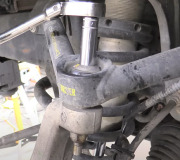I assume you are referring to the rear lower control arms. When the manufacturer cannot be bothered to put adjustments on the car, parts of different sizes are not meant for minor corrections. They are used to solve a common problem, such as a pull to one side that shows up on every one of that model, or when corrections are needed after crash damage is repaired.
To add to the misery, the control arms correct toe errors. Toe is the direction the wheel is steering, and it is important to understand that toe error on either wheel causes bad tire wear patterns on both tires on that axle. If you do not have a choppy or feather-edge pattern on both tires, you likely do not have a toe problem that needs correction.
Minus 1.9 degrees camber means you should easily see the top of that tire tipped in on top. That will cause accelerated tread wear on the inner edge, but only on that one tire. That will require considerable correction, but if no bent parts have been identified, the much better suspect is sagged ride height, especially due to the age of the car. We always measure ride height as part of an alignment because we can make the numbers on the computer look good, but that is only for a car that is standing still. The entire suspension system is a complicated series of geometric angles, and the changes they go through are designed to keep the wheels in alignment as that geometry changes, meaning the car is bouncing up and down as it goes down the road. Ride height sets the starting point for those angles and must be correct.
Every shop has a small book that shows where to take the height measurement on every car model and year, and what they should be. Most shops will not even try to align a car with sagged ride height because they know there is still going to be rapid tire wear.
The good news is ride height is corrected by replacing the coil springs, and that is not a very expensive job. Look at that first before trying to replace parts that are not worn. Next, look for bent parts, but those can be difficult to see. When simply replacing a part to make an adjustment, you have to know what size part you are removing. Often the only way to tell is by putting one on, then checking the alignment numbers to know if a change occurred. For me that means having multiple parts right there by the alignment rack. For you that means running back and forth and paying for multiple alignments.
Monday, September 25th, 2017 AT 8:00 PM


